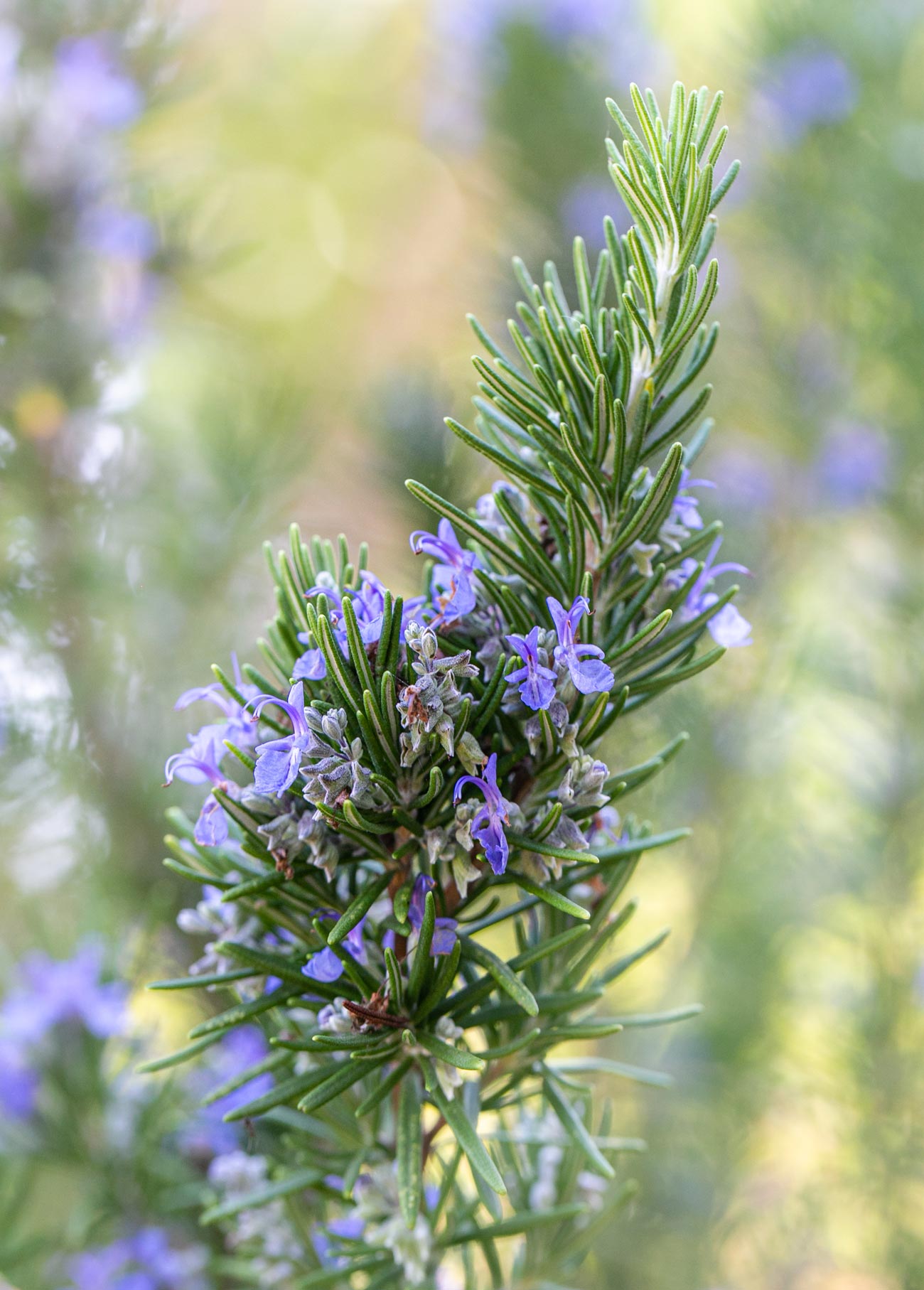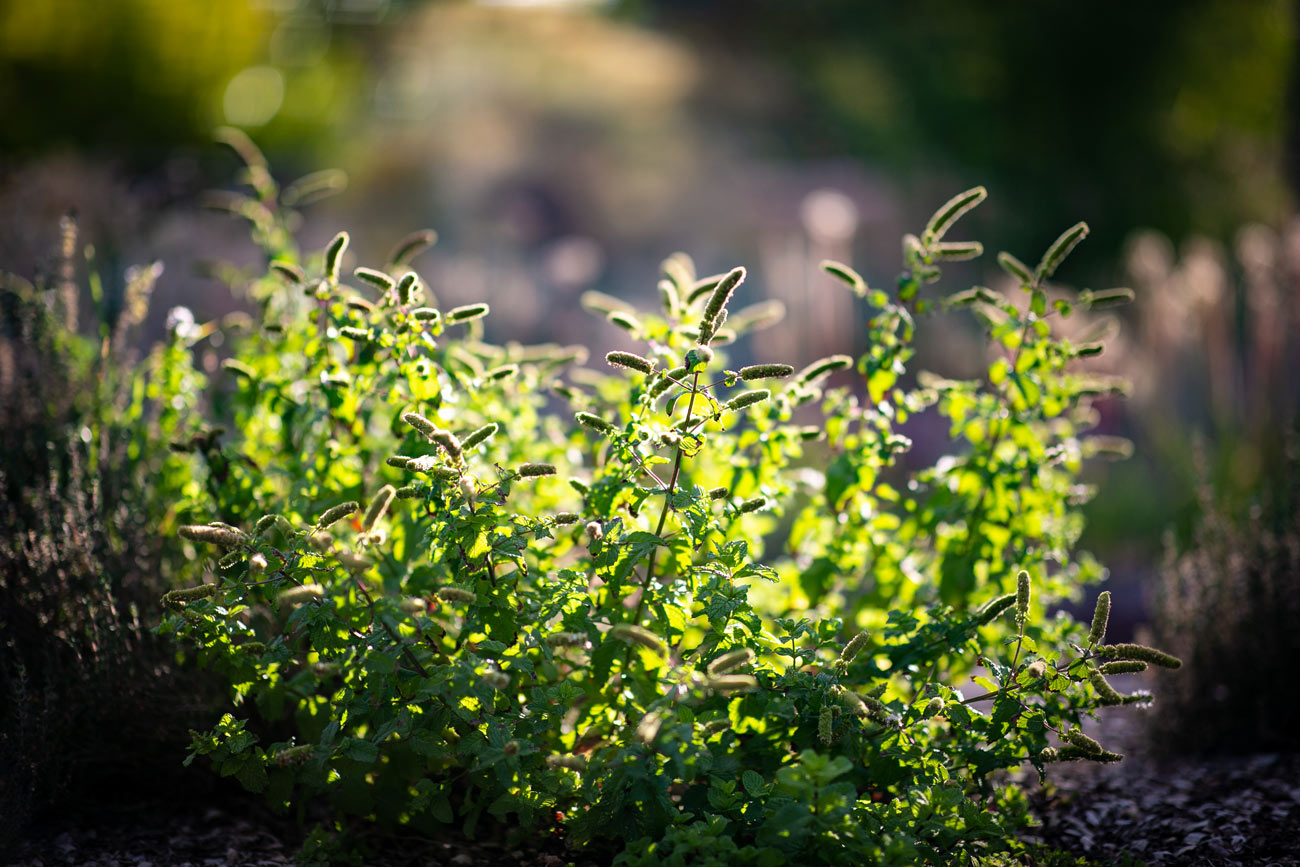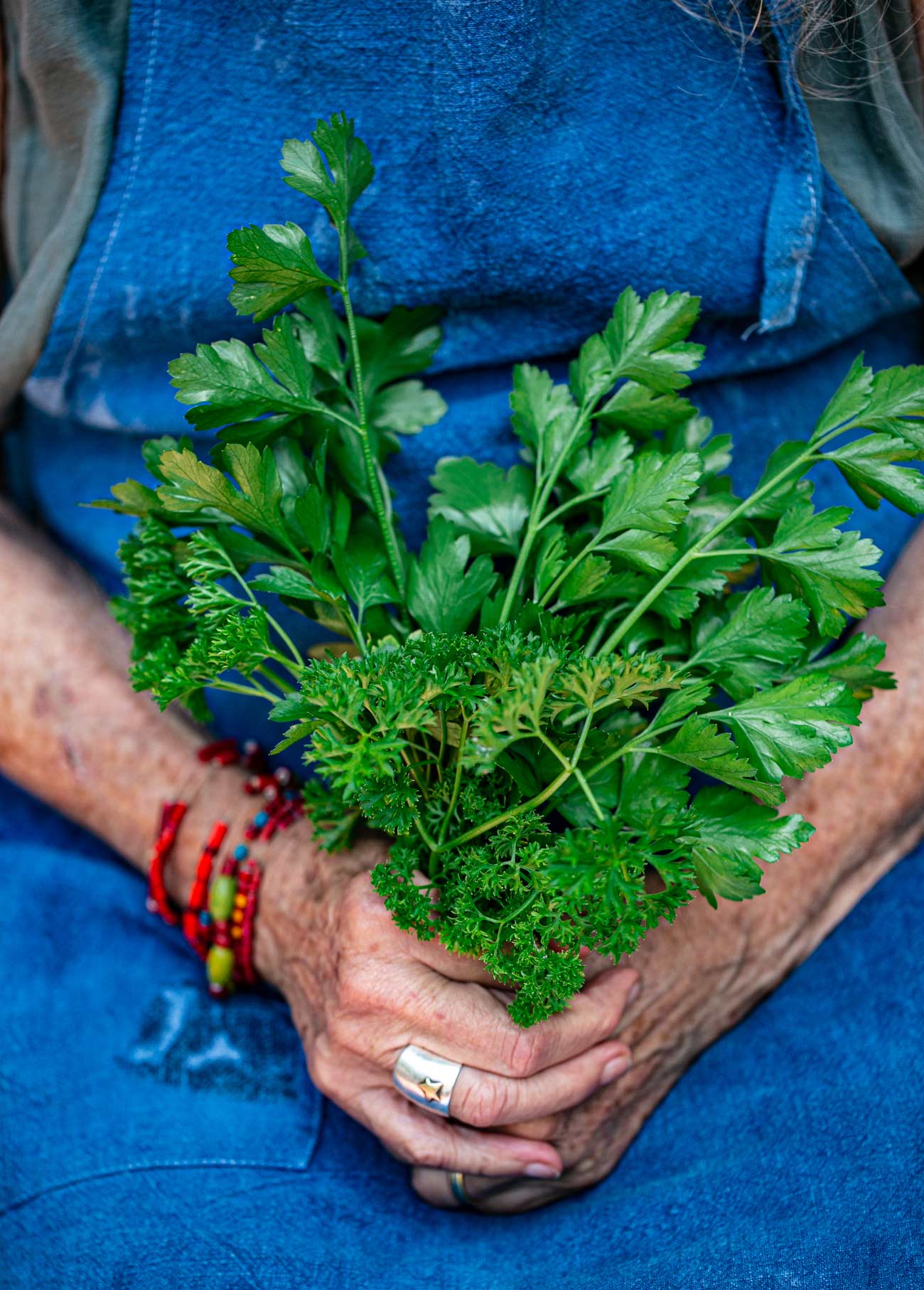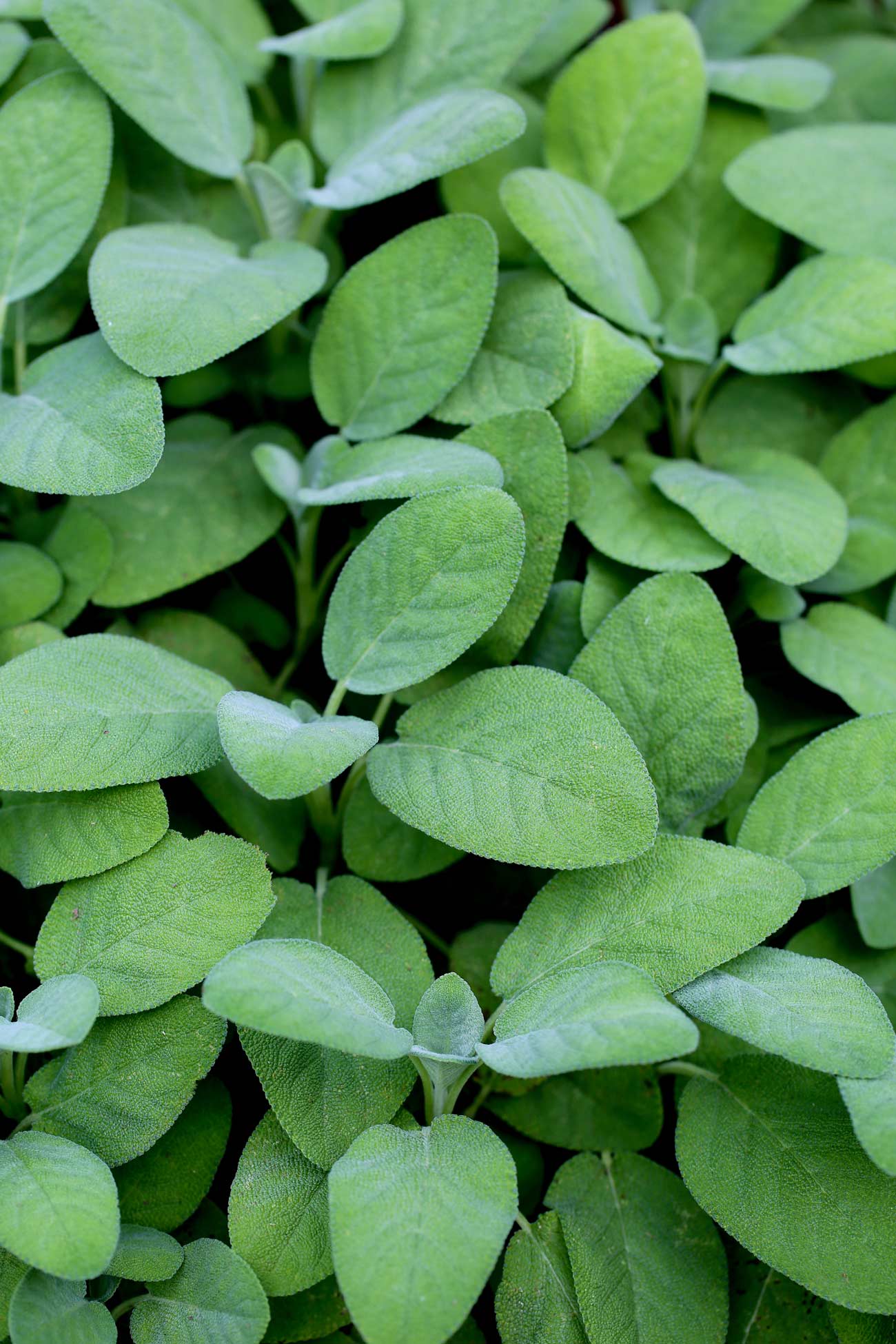The Medicinal Culinary Herb Garden
Text by Meghan Gemma with Juliet Blankespoor, Photographs by Juliet Blankespoor
Your spice cabinet is medicine masquerading as food—and so is your culinary herb garden. Both are zesty apothecaries that speak the universal languages of aroma and flavor. Most culinary herbs, from sage (Salvia officinalis) to cinnamon (Cinnamomum verum), are packed with healing properties. Rosemary (Salvia rosmarinus), for example, helps to sharpen our minds and memories; oregano (Origanum vulgare) is potently antimicrobial; basil (Ocimum basilicum) aids digestion and enlivens our spirits; and garlic (Allium sativum) is healing for our hearts. Each and every time we spice our foods, we are also sprinkling on a well-disguised dose of medicine.

Purple leaf sage (Salvia officinalis 'Purpurascens')
The human relationship with seasoning and spice is multidimensional. Nearly every (if not all) culture around the world enhances the flavor of their food with herbs, but herbal cooking goes beyond simple gustatory pleasure. Many culinary herbs are potently antimicrobial and act as natural food preservatives. Spices like garlic, oregano, cayenne pepper (Capsicum annuum), and thyme (Thymus vulgaris) all help combat foodborne microorganisms, thereby keeping our food fresher for longer—an especially important quality in hot, humid climates and in places without refrigeration. And, of course, nothing helps our medicine go down better than when it’s stirred into something delicious. Lucky for us, today’s herbal recipes far outshine Mary Poppins’s “spoonful of sugar.”

Thyme (Thymus sp.) in bloom
Medicinals like anise hyssop (Agastache foeniculum), hibiscus (Hibiscus sabdariffa), bee balm (Monarda spp.), lavender (Lavandula angustifolia), calendula (Calendula officinalis), and nettles (Urtica dioica) are growing in popularity as culinary herbs, and for good reason—they more than make the cut for the dinner table; they’re divine. What a brilliant stroke of plant–human synergy that so many healing herbs taste so good. Knowing this adds a new element of excitement and inventiveness to our preparation of food.
Curious what food-as-medicine can look like? A rainbow of delectable, nourishing, and beautiful-to-behold possibilities, including lemon balm pesto, nettles pâté, garlic sauce, hibiscus pomegranate fire cider, hibiscus chutney, calendula tulsi chai, turmeric chives chipotle deviled eggs, and lavender truffles. And that’s just the herbal amuse-bouche. No one will ever suspect they’re eating or imbibing medicine (because it will taste like a dream), but you’ll know that the food and drink on your table is infused with antioxidant, anti-inflammatory, detoxifying, and nourishing qualities.
Culinary Herb Featurettes

Rosemary (Salvia rosmarinus) in bloom
Rosemary
(Salvia rosmarinus, Lamiaceae)
Parts Used: Leaves
Medicinal Preparations: Culinary, tea, tincture, infused oil, vinegar, and herbal steam
Herbal Actions:
- Aromatic
- Antioxidant
- Nervine
- Antidepressant
- Carminative
- Circulatory stimulant
- Antimicrobial
Medicinal and Culinary Uses: Resinous and aromatic, rosemary sprigs can be bound together with other herbal companions in fragrant smoke bundles for cleansing and purification.
Rosemary is classically known as an aid for memory and concentration in tea or tincture formulas with gotu kola (Centella asiatica) and ginkgo (Ginkgo biloba). Topically, it is astringent and makes an excellent hair wash for those with oily to medium hair.
Taken tonically, rosemary can improve circulation and quench free radicals through its antioxidant qualities. It can also calm nervous complaints, especially when digestive flare-ups are paired with tension or headache.
Rosemary is a classic kitchen herb used to spice any number of savory dishes—including poultry, fish, root vegetables, stews, and red meat. It has also become a popular ingredient in craft cocktails and mocktails.
Cultivation: Rosemary plants that attain old age are elegant and enticing beyond comparison. With soft blue to purple edible blooms and a singular aroma, they are often the herbal pièce de résistance on the patio. Lucky for us, rosemary grows easily and thrives in containers. Rosemary has a penchant for sunlight and soils that drain easily—imagine the climate and terrain of its native Mediterranean habitat. You can mimic these conditions by stirring plenty of sand into your soil mix and letting the soil dry between each watering.
If you live in zone 7 or colder, you’ll want to bring potted rosemary plants indoors over the winter and place them in a south-facing window. Otherwise, you may need to provide artificial light.
Harvesting rosemary frequently will encourage plants to become lush and bushy. Using a sharp pair of kitchen scissors, snip off the top few inches of growth from each sprig.
Precautions: Avoid using rosemary in large or medicinal doses during pregnancy and breastfeeding/chestfeeding. Culinary doses are fine.

Spearmint (Mentha spicata), going to seed
Mints
(Mentha spp., Lamiaceae)
Parts Used: Leaves and flowering stems
Medicinal Preparations: Infusion, vinegar, honey, oxymel, liniment, compress, poultice, soak, and condiment
Herbal Actions:
- Carminative
- Nervine
- Diaphoretic
- Antimicrobial
- Decongestant
- Antiemetic
- Anodyne
Medicinal and Culinary Uses: The garden mints can all be used medicinally—peppermint, spearmint, chocolate mint, lime mint, orange mint, and apple mint are all interchangeable. Mint is a classic herb for relieving intestinal gas and bloating, as well as nausea stemming from motion sickness, migraines, or morning sickness. With decongestant properties, the herb helps clear the sinuses in colds and flu, seasonal allergies, and sinus infections. Mint helps with concentration and focus, especially when combined with rosemary (Salvia rosmarinus), gotu kola (Centella asiatica), and tulsi (Ocimum tenuiflorum) in tea or tincture form.
Worldwide, spearmint is the most popular mint for culinary use, but you might play around with different varieties in your cuisine. During the warm months, I mince fresh leaves into salads and dressings, and churn up a batch or two of peppermint ice cream. It also makes a cooling and refreshing beverage tea (spearmint is my hands-down favorite in this case).
Ready to dive deeper into your herbal studies?
Save 20% with code MINICOURSE20
Springtime Fairy Vinegar with Fresh Garden Herbs & Weeds
My daughter and I like to celebrate springtime by gathering up our baskets, greeting the sunshine, and picking fresh wild and garden herbs for “fairy vinegar.” The lawn and gardens are filled with medicinal herbs during this time. I call it fairy vinegar because all the plants are so little and darling this time of year, and because a pinch of this and a pinch of that, topped off with wee blossoms, has a magical feeling.
Be 150% sure of your identification before gathering any wild plants, and harvest from clean (unsprayed) locales only. Visit our blog to learn more about safe and sustainable gathering practices and to find a list of our favorite foraging field guides. You can also join us for our Foraging Course to learn more about the wonders of wild and weedy herbs.
A handful of each of the following herbs, freshly picked and not dried:
- Mint, leaf (Mentha spp.)
- Dandelion, leaf and flowers (Taraxacum officinale)
- Stinging nettles, leaf (Urtica dioica)
- Cleavers, leaf and stem (Galium aparine)
- Chickweed, herb (Stellaria media)
- Violet, leaf and flowers (Viola spp.)
- Plantain, leaf (Plantago spp.)
- Red clover, flowers (Trifolium pratense)
- Purple dead nettle, leaf and flowers (Lamium purpureum)
- Garlic mustard, leaf (Alliaria petiolata)
- Creasy greens, leaf (Barbarea verna)
After washing your fresh herbs, combine a handful of each in a sterilized quart jar and prepare your vinegar. Try making your own version from whatever darlings are springing up in your garden and fields. If you aren’t familiar with any of these wild foods, you can buy dandelion greens and burdock root from the market, and include emerging herbs from your garden, like lemon balm (Melissa officinalis) and bee balm (Monarda didyma).
Many of the herbs above are rich in minerals and are traditional blood cleansers or “spring tonics.” This vinegar is a wonderful way to get your gears greased and your engine revving after the slowness of wintertime. The daily dosage is 1–3 Tablespoons (15–45 ml).
Cultivation: Mint is an herb to grow and know, even for the brownest of thumbs. It is the best herb for beginner gardeners and a prime suspect for children’s gardens. Just know you’ll need to curtail the herb’s wayfaring tendencies or it will take over; alternatively, plant mints in large containers.
Mint needs to be propagated by root divisions or stem cuttings as the seeds will not come up true to type. It is one of the easiest plants to divide and transplant—any piece of the stolon (the running, underground stem) with roots can be divided. Harvest the flowering stems when the plants are just beginning to bloom, and hang in bundles to dry. This will yield the highest concentration of essential oils and the most potent medicine.
Precautions: Mint can sometimes aggravate heartburn and irritate ulcers or cause inflammation in the gastrointestinal tract.

Parsley
(Petroselinum crispum, Apiaceae)
Parts Used: Leaves
Medicinal Preparations: Tea, pesto, vinegar, infused oils, compound butters, marinades, dressings, fresh juice, and bouquet garni
Herbal Actions:
- Antioxidant
- Carminative
- Diuretic
- Emmenagogue
Medicinal and Culinary Uses: Have you ever wondered how parsley landed the starring role as garnish de rigueur on dinner plates around the world? Perhaps it has to do with parsley’s ability to stay perky throughout a three-course meal, or it may be a nod to herbal culinary tradition: parsley has a beneficial effect on lackluster digestion; it eases gas and bloating, and freshens the breath. Parsley is also a nutritional powerhouse—it’s high in vitamins A, C, and K (which are linked to heart and bone health).
I prefer to eat parsley as a condiment or seasoning herb. I blend it into green sauces, pestos, dressings, and marinades. Throughout the summer, I also add generous handfuls to big bowls of tabbouleh.
Parsley is a folk remedy to slow breast/chest milk production. Garden sage is likewise used for this purpose; the two are used as herbal allies in weaning. Parsley is also an emmenagogue and blood tonic; it can help to bring on delayed menses as well as encourage a healthy menstrual cycle.
Cultivation: Parsley is typically grown as an annual herb, as the leaves become bitter upon flowering during its second year. Harvest the outer leaves, taking only ⅓ of the plant, to allow new leaves to regrow from the center crown.
In hot climates, parsley will appreciate a bit of afternoon shade, and can be planted as a fall and winter crop. Parsley flourishes in containers as long as the soil is rich and doesn’t dry out. It can be grown indoors in a sunny windowsill, and outdoors in window boxes, hanging baskets, mixed herbal pots, and garden beds.
Precautions: Do not use medicinally or consume large amounts during pregnancy or breastfeeding/chestfeeding.

Garden sage (Salvia officinalis 'Berggarten')
Garden Sage
(Salvia officinalis, Lamiaceae)
Parts Used: Leaves
Medicinal Preparations: Tea, tincture, infused oil, compress, wash, gargle, tooth powder, and infused vinegar
Herbal Actions:
- Antibacterial
- Antifungal
- Carminative
- Antioxidant
- Anti-inflammatory
- Bitter
- Cholagogue
Medicinal and Culinary Uses: Classic garden sage has a special affinity for the mouth and throat, and is treasured as a gargle or rinse for sore throat, canker sores, periodontal disease, bad breath, and cold sores. It has a rich tradition of use as a mental stimulant and is often added to formulas to aid concentration, memory, and focus.
This herb is unique in that it can slow breast/chest milk production and sweating. For these purposes, it should be drunk at room temperature in small doses throughout the day. Sage is commonly employed with motherwort (Leonurus cardiaca) in reducing hot flashes during menopause.
Sage is renowned for its pungent resinous flavor and its ability to complement fatty foods. Indeed, our taste buds may be speaking for our stomachs in this department, as sage is one of the best culinary herbs for enhancing the digestion of fats (by stimulating bile). Sage is often thought of as the poultry seasoning, but it is equally at home with winter squash and roasted roots.
Cultivation: Sage will grow like a dream in the garden and in containers, as long as the soil is well-drained. If you live in a colder, four-season climate, be sure to overwinter sage indoors in a south-facing window to avoid cold season casualties.
As with most mint family members, pinching back the growing tips will encourage bushiness. In the spring of each year before the plants begin to regrow, cut them back by a third to discourage woodiness. Continue with this pruning regime every year to keep the plants perky and promote fresh succulent shoots. Sage is often a short-lived perennial, petering out or becoming woody after several years.
Precautions: Sage should be avoided in medicinal doses during pregnancy. Smaller culinary doses are considered safe. Avoid during lactation, unless you are weaning, as sage will slow milk production.

Thyme (Thymus sp.) blooms, close up
Thyme
(Thymus vulgaris, Lamiaceae)
Parts Used: Leaves and flowering tops
Medicinal Preparations: Culinary, tea, tincture, herbal steam, infused honey, vinegar, and infused oil
Herbal Actions:
- Antimicrobial
- Carminative
- Diaphoretic
- Expectorant
- Antispasmodic
- Emmenagogue
Medicinal and Culinary Uses: Thyme is one of my favorite culinary herbs and is highly revered in French, Italian, and other Mediterranean cuisines. It can be added to homemade herbes de provence blends or used on its own to flavor poultry, root vegetables, stews, sauces, and marinades. Experiment with thyme varieties—lemon thyme and orange thyme both impart a savory citrus flavor to dishes.
Like many mint-family herbs, thyme is stimulating to the digestive system—easing uncomfortable symptoms like gas and bloating. Its antimicrobial activity lends it to topical wound care and fungal and yeast infections, and internally for digestive and respiratory infections.
Thyme is one of the first herbs I add to steam pots—it helps relieve inflammation and break up congestion. Combined with its antispasmodic and expectorant properties, thyme is a traditional remedy for painful, hacking coughs, including conditions like whooping cough and bronchitis.
Herbal Steam for Respiratory Infections
Steams are a deeply soothing way to bring medicine into our lives; this blend offers relief from respiratory congestion and infection. You only need a few household items to prepare a healing herbal steam.
- Thyme leaf (Thymus vulgaris)
- Garden sage leaf (Salvia officinalis)
Bring a pot of water to a boil. Place your herbs in a heat-safe bowl or pot. Use the following proportions: ¼ cup of herb, or herbal combination, for every cup of water. Pour hot water over the herbs and cover until you’re ready to steam, to keep the precious volatile oils from escaping. Place a large towel over both your head and the bowl. Make yourself comfortable, and inhale.
Be careful not to get burned! Make sure your towel is large enough to allow some space between yourself and the hot water. You do not want your face to be directly over the bowl.
Cultivation: Thyme hails from the same Mediterranean soils as rosemary (Salvia rosmarinus) and sage (Salvia officinalis), and likewise prefers similar growing conditions—namely: full sun, warm days, and well-drained soil. If growing in containers, be sure to add a generous helping of sand to your potting mix and let the soil dry out completely between waterings.
Harvest thyme in a “cut-and-come-again” style; simply give the plant a haircut early in the season and it will grow back lickety-split. If you enjoy the look of mixed plantings, consider pairing thyme in a pot with rosemary and strawberries.
Precautions: In high doses, thyme is an emmenagogue (stimulates uterine contractions and/or menstrual flow) and should be avoided in pregnancy. Culinary doses, lower in nature, are generally considered to be safe.
All Content, Photography, and Text, ©Juliet Blankespoor unless otherwise noted. Distribution, resale, or sharing of this material is illegal and punishable by law. Please respect the hours that went into creating this resource.
Dive deeper into your herbal studies!
Enroll in one of Chestnut School’s herbalism programs today.
Course Navigation
More Resources

